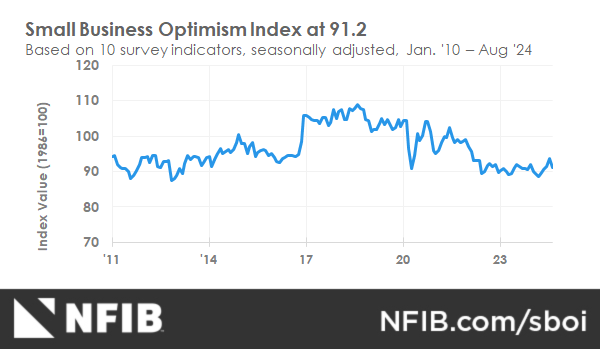Bussiness
NFIB Minnesota’s John Reynolds Reacts to Small Business Optimism Dip | NFIB

Main Street owners grapple with uncertainty as sales expectations decrease
The NFIB Small Business Optimism Index fell by 2.5 points in August to 91.2, erasing all of July’s gain. This is the 32nd consecutive month below the 50-year average of 98. The Uncertainty Index rose to 92, its highest level since October 2020. Inflation remains the top issue among small business owners, with 24% of owners reporting it as their top small business operating issue, down one point from July.
“The mood on Main Street worsened in August, despite last month’s gains,” said NFIB Chief Economist Bill Dunkelberg. “Historically high inflation remains the top issue for owners as sales expectations plummet and cost pressures increase. Uncertainty among small business owners continues to rise as expectations for future business conditions worsen.”
“The recent drop in the Small Business Optimism Index is troubling for small businesses in Minnesota and around the country,” said NFIB State Director John Reynolds. “Main Street continues to feel the lasting effects of inflation, workforce shortages, and shrinking margins. Small businesses reporting the worst profit trend in fourteen years should sound alarm bells in St. Paul and Washington, D.C., especially as mom-and-pop shops face a major increase in federal taxes if the Small Business Deduction expires next year.”
Key findings include:
- The frequency of reports of positive profit trends was a net negative 37% (seasonally adjusted), seven points worse than in July and the lowest since March 2010.
- Twenty-four percent of owners reported inflation as their single most important problem in operating their business, down one point from July.
- The net percent of owners expecting higher real sales volumes fell nine points in August to a net negative 18% (seasonally adjusted). Real sales volume expectations were the largest contributor to the decline in the Optimism Index along with earning trends and expected business conditions.
- A seasonally adjusted net 20% plan to raise compensation in the next three months, up two points from July.
- The net percent of owners raising average selling prices fell two points from July to a net 20% seasonally adjusted.
As reported in NFIB’s monthly jobs report, a seasonally adjusted 40% of all small business owners reported job openings they could not fill in their current period, up two points from July. Of the 62% of owners hiring or trying to hire in August, 90% reported few or no qualified applicants for the positions they were trying to fill.
Fifty-six percent of owners reported capital outlays in the last six months, up two points from July. Of those making expenditures, 40% reported spending on new equipment, 21% acquired vehicles, and 18% improved or expanded facilities. Eleven percent spent money on new fixtures and furniture and 5% acquired new buildings or land for expansion. Twenty-four percent (seasonally adjusted) plan capital outlays in the next six months, up one point from July.
A net negative 16% of all owners (seasonally adjusted) reported higher nominal sales in the past three months. The net percent of owners expecting higher real sales volumes fell nine points to a net negative 18% (seasonally adjusted).
The net percent of owners reporting inventory gains was unchanged at a net negative 9%, seasonally adjusted. Not seasonally adjusted, 11% reported increases in stocks and 18% reported reductions.
A net negative 5% (seasonally adjusted) of owners viewed current inventory stocks as “too low” in August, down one point from July. A net negative 1% (seasonally adjusted) of owners plan inventory investment in the coming months, down three points from July.
The net percent of owners raising average selling prices fell two points from July to a net 20% seasonally adjusted. Twenty-four percent of owners reported that inflation was their single most important problem in operating their business. Unadjusted, 15% reported lower average selling prices and 34% reported higher average prices.
Price hikes were the most frequent in the finance (52% higher, 3% lower), retail (47% higher, 8% lower), construction (33% higher, 16% lower), and manufacturing (33% higher, 7% lower) sectors. Seasonally adjusted, a net 25% plan price hikes in August.
Seasonally adjusted, a net 33% reported raising compensation, unchanged from July and the lowest reading since April 2021. A seasonally adjusted net 20% plan to raise compensation in the next three months, up two points from July. Nine percent of owners cited labor costs as their top business problem, unchanged from July and only four points below the highest reading of 13% reached in December 2021. Twenty-one percent said that labor quality was their top business problem, remaining behind inflation as the number one issue.
The frequency of reports of positive profit trends was a net negative 37% (seasonally adjusted), seven points worse than in July and the lowest since March 2010. Among owners reporting lower profits, 31% blamed weaker sales, 17% blamed the rise in the cost of materials, 13% cited labor costs, and 10% cited lower selling prices. For owners reporting higher profits, 45% credited sales volumes, 35% cited usual seasonal change, and 10% cited higher selling prices.
Three percent of owners reported that all their borrowing needs were not satisfied. Twenty-six percent reported all credit needs met and 60% said they were not interested in a loan. A net 7% reported their last loan was harder to get than in previous attempts.
Four percent of owners reported that financing was their top business problem in August, up one point from July.
The NFIB Research Center has collected Small Business Economic Trends data with quarterly surveys since the fourth quarter of 1973 and monthly surveys since 1986. Survey respondents are randomly drawn from NFIB’s membership. The report is released on the second Tuesday of each month. This survey was conducted in August 2024.









